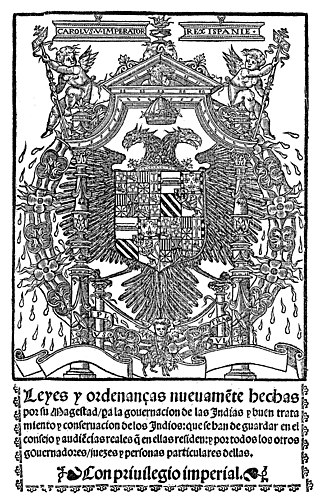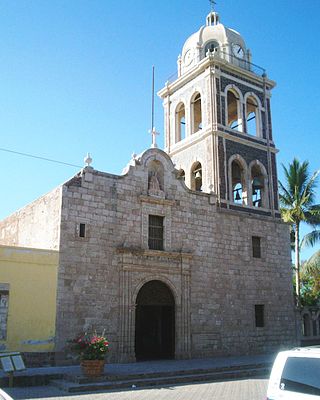
The Spanish colonization of the Americas began in 1493 on the Caribbean island of Hispaniola after the initial 1492 voyage of Genoese mariner Christopher Columbus under license from the Queen Isabella I of Castile. These overseas territories of the Spanish Empire were under the jurisdiction of Crown of Castile until the last territory was lost in 1898. Spaniards saw the dense populations of indigenous peoples as an important economic resource and the territory claimed as potentially producing great wealth for individual Spaniards and the crown. Religion played an important role in the Spanish conquest and incorporation of indigenous peoples, bringing them into the Catholic Church peacefully or by force. The crown created civil and religious structures to administer the vast territory. Spanish colonists settled in greatest numbers where there were dense indigenous populations and the existence of valuable resources for extraction.

New Spain, officially the Viceroyalty of New Spain, or Kingdom of New Spain, was an integral territorial entity of the Spanish Empire, established by Habsburg Spain during the Spanish conquest of the Americas and having its capital in Mexico City. Its jurisdiction comprised a large area that included what is now Mexico, the Western and Southwestern United States in North America; Central America, the Caribbean, very northern parts of South America, and several territorial Pacific Ocean archipelagos.

The Viceroyalty of Peru was a Spanish imperial provincial administrative district, created in 1542, that originally contained modern-day Peru and most of the Spanish Empire in South America, governed from the capital of Lima. The Viceroyalty of Peru was officially called the Kingdom of Peru. Peru was one of the two Spanish Viceroyalties in the Americas from the sixteenth to the eighteenth centuries.

A hacienda is an estate, similar to a Roman latifundium, in Spain and the former Spanish Empire. With origins in Andalusia, haciendas were variously plantations, mines or factories, with many haciendas combining these activities. The word is derived from Spanish hacer and haciendo (making), referring to productive business enterprises.

The encomienda was a Spanish slave labour system that rewarded conquerors with the labour of conquered non-Christian peoples. The labourers, in theory, were provided with benefits by the conquerors for whom they laboured, including military protection and education. The encomienda was first established in Spain following the Christian conquest of Moorish territories, and it was applied on a much larger scale during the Spanish colonization of the Americas and the Spanish Philippines. Conquered peoples were considered vassals of the Spanish monarch. The Crown awarded an encomienda as a grant to a particular individual. In the conquest era of the early sixteenth century, the grants were considered to be a monopoly on the labour of particular groups of indigenous peoples, held in perpetuity by the grant holder, called the encomendero; following the New Laws of 1542, upon the death of the encomendero, the encomienda ended and was replaced by the repartimiento.

The New Laws, also known as the New Laws of the Indies for the Good Treatment and Preservation of the Indians were issued on November 20, 1542, by Charles V, Holy Roman Emperor and regard the Spanish colonization of the Americas. Following denunciations and calls for reform from individuals such as the Dominican friar Bartolomé de Las Casas, these laws were intended to prevent the exploitation and mistreatment of the indigenous peoples of the Americas by the encomenderos, by limiting their power and dominion over groups of natives.

José Gabriel Condorcanqui – known as Túpac Amaru II – was an indigenous cacique who led a large Andean rebellion against the Spanish in Peru as self-proclaimed Sapa Inca of a new Inca Empire. He later became a mythical figure in the Peruvian struggle for independence and indigenous rights movement, as well as an inspiration to myriad causes in Spanish America and beyond.
Mit'a was mandatory service in the society of the Inca Empire. Its close relative, the regionally mandatory Minka is still in use in Quechua communities today and known as faena in Spanish.

The patio process is a process for extracting silver from ore. Smelting, or refining, is most often necessary because silver does not very frequently occur in the nature by itself as a native element mineral like some metals nobler than the redox couple 2 H+ + 2 e−⇌ H
2 (gold, mercury, ...). Instead, it is made up of a larger ore body. Thus, smelting, or refining, is necessary to reduce the Ag+ cation into metallic Ag and to remove other byproducts to get at pure silver. The process, which uses mercury amalgamation to recover silver from ore, was reportedly invented by Bartolomé de Medina in Pachuca, Mexico, in 1554. It replaced smelting as the primary method of extracting silver from ore at Spanish colonies in the Americas. Although some knowledge of amalgamation techniques were likely known since the classical era, it was in the New World that it was first used on a large industrial scale. Other amalgamation processes were later developed, importantly the pan amalgamation process, and its variant, the Washoe process. The silver separation process generally differed from gold parting and gold extraction, although amalgamation with mercury is also sometimes used to extract gold. While gold was often found in the Americas as a native metal or alloy, silver was often found as a compound such as silver chloride and silver sulfide, and therefore required mercury amalgamation for refinement.
The Repartimiento was a colonial labor system imposed upon the indigenous population of Spanish America. In concept, it was similar to other tribute-labor systems, such as the mit'a of the Inca Empire or the corvée of the Ancien Régime de France: Through the pueblos de indios, the Amerindians were drafted work for cycles of weeks, months, or years, on farms, in mines, in workshops (obrajes), and public projects.

Indian reductions in the Andes were settlements in the former Inca Empire created by Spanish authorities and populated by the forcible relocation of indigenous Andean populations, called "Indians" by the Spanish and "Andeans" by some modern scholars. The purpose of the Spanish Empire was to gather native populations into centers called "Indian reductions", to Christianize, tax, and govern them to comply with Spanish customs and economic interests.

Santa Ana de la Ribera de Tarma is the capital city of Tarma Province in Junín Region, Perú.

Francisco Álvarez de Toledo, also known as The Viceroyal Solon, was an aristocrat and soldier of the Kingdom of Spain and the fifth Viceroy of Peru. Often regarded as the "best of Peru's viceroys", he is as often denounced for the negative impact his administration had on the Indigenous peoples of Peru.

Reductions were settlements created by Spanish rulers and Roman Catholic missionaries in Spanish America and the Spanish East Indies. In Portuguese-speaking Latin America, such reductions were also called aldeias. The Spanish and Portuguese relocated, forcibly in many cases, indigenous inhabitants of their colonies into urban settlements modeled on those in Spain and Portugal.

A kuraka, or curaca, was an official of the Inca Empire who held the role of magistrate, about four levels down from the Sapa Inca, the head of the Empire. The kurakas were the heads of the ayllus. They served as tax collector, and held religious authority, in that they mediated between the supernatural sphere and the mortal realm. They were responsible for making sure the spirit world blessed the mortal one with prosperity, and were held accountable should disaster strike, such as a drought. Kurakas enjoyed privileges such as being exempt from taxation, the right to polygamy and to ride in a litter.

The history of Lima, the capital of Peru, began with its foundation by Francisco Pizarro on January 18, 1535. The city was established on the valley of the Rímac River in an area populated by the Ichma polity. It became the capital of the Viceroyalty of Peru and site of a Real Audiencia in 1543. In the 17th century, the city prospered as the center of an extensive trade network despite damage from earthquakes and the threat of pirates. However, prosperity came to an end in the 18th century due to an economic downturn and the Bourbon Reforms.
Yanakuna were originally individuals in the Inca Empire who left the ayllu system and worked full-time at a variety of tasks for the Inca, the quya, or the religious establishment. A few members of this serving class enjoyed high social status and were appointed officials by the Sapa Inca. They could own property and sometimes had their own farms, before and after the conquest. The Spanish continued the yanakuna tradition developing it further as yanakuna entered Spanish service as Indian auxiliaries or encomienda Indians.
Francisco Pizarro and his fellow conquistadors from the rapidly growing Spanish Empire first arrived in the New World in 1524. But even before the arrival of the Europeans, the Inca Empire was floundering. Pizarro enjoyed stunning successes in his military campaign against the Incas, who, despite some resistance, were defeated and in 1538 the Spaniards completely defeated Inca forces near Lake Titicaca, allowing Spanish penetration into central and southern Bolivia.

An encomienda in Peru was a reward offered to each of the men under the leadership of Francisco Pizarro who began the Spanish conquest of the Inca Empire in 1532. In the early colonial period of the New World, land had little economic value without the labor to exploit it. The grant of an encomienda gave the grantee, the encomendero, the right to collect tribute from a community of indigenous people." The word "encomienda" means "trust", indicating that the indigenous people were entrusted to the care and attention of an encomendero. In reality, the encomienda system is often compared to slavery. Theoretically, the encomendero did not own the people or the land occupied by his subjects, but only the right to tribute, usually in the form of labor, that he could extract from them.
Polo Ondegardo was a Spanish colonial jurist, civil servant, businessman and thinker who proposed an intellectual and political vision of profound influence in the earliest troubled stage of the contact between the Hispanic and the American Indigenous world. He was born in Valladolid, when the city was the capital of the kingdom of Castile, to a prominent noble family that had strong ties to the royal family. He spent his entire adult life in South America in what is now Peru and Bolivia. He was involved in the political and economic management of the Spanish colony and based on his good knowledge of the laws as licenciado (licentiate) acquired a deep knowledge and practical experience of the Native Americans in the southern Andes, being an encomendero, visitador and corregidor in the provinces of Charcas and Cusco. His administrative reports, well known and appreciated by his peers and contemporaries, have had wide repercussions in the field of Andean studies up to the present time.














